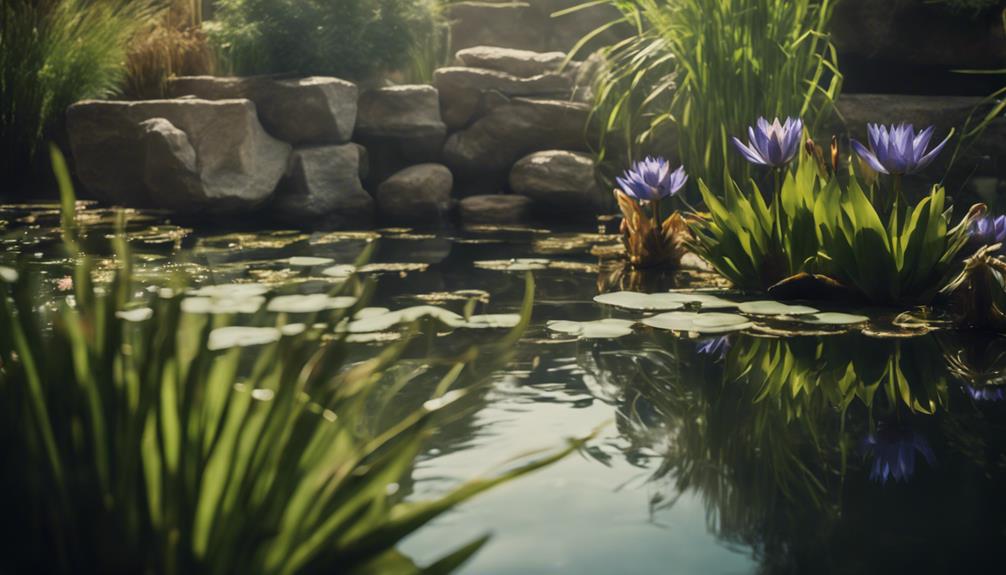You're looking to add some life to your water feature! When it comes to aquatic plants, you've got three top options. For the water's edge, bog plants like umbrella palm and marsh marigold create a natural filtration system and add vibrant green foliage. Floating plants like Water Lettuce and Sensitive Plant thrive on the surface, requiring minimal maintenance. And for a deeper installation, deep emergent plants like Water Lilies and Sweet Flag offer shelter for aquatic life and visual interest. By choosing the right plants for your water feature, you'll not only enhance its aesthetic appeal but also maintain water quality and ecosystem balance – and there's more to explore when it comes to creating a thriving aquatic environment.
Table of Contents
Key Takeaways
- Bog plants like umbrella palm and marsh marigold create a natural filtration system and add vibrant green foliage to the pond surroundings.
- Floating plants like Water Lettuce and Sensitive Plant thrive on the water's surface, requiring minimal maintenance and creating a serene atmosphere.
- Deep emergent plants like water lilies and sweet flag offer visual interest and ecological functionality, providing shelter for fish and other aquatic life.
- Cardinal flower, a vibrant, red-flowering plant, attracts hummingbirds, reduces algae growth, and improves water clarity in ponds and water features.
- Selecting plant species compatible with the water feature's size, depth, and climate is crucial for the health and vitality of aquatic plants.
Bog Plants for Water Features
When designing a water feature, you'll find that bog plants are an excellent choice for the water's edge, as they thrive in moist soil and don't require submersion in water.
These marginal plants, such as umbrella palm and marsh marigold, create a natural filtration system, adding structure and vibrant green foliage to the pond surroundings.
By incorporating bog plants into your water feature, you'll not only enhance its aesthetic appeal but also maintain water quality and ecosystem balance.
As a habitat for aquatic life, bog plants provide shelter for frogs, insects, and fish, fostering a thriving ecosystem.
To guarantee the health and vitality of your bog plants, selecting species compatible with your water feature's size, depth, and climate is paramount.
Regular maintenance is also pivotal to prevent overcrowding and maintain water quality.
Floating Plants for Ponds
You can transform the surface of your pond with floating plants, which thrive on the water's surface and require minimal maintenance.
These aquatic plants are perfect for creating a serene atmosphere in your water gardens.
Among the popular floating plants, Water Lettuce (Pistia stratiotes) is a great choice, with its large velvety leaves that spread quickly, making it suitable for large fountains.
Sensitive Plant (Neptunia aquatica) is another option, with its mini fern leaves that close at night and produce yellow or magenta flowers that bloom all summer long.
If you're looking for a plant that can create a blanket of clovers over your water surface, Lucky 4-Leaf Clover (Marsilea mutica) is a great option, requiring full sun to partial shade.
Moneywort (Bacopa monnieri) and Mosaic Flower (Ludwigia sedioides) are also great choices, providing a dense 'carpet' on the water and creating green and red rosettes of diamond-shaped leaves, respectively.
Deep Emergent Plant Options

Deep emergent plants, which thrive in water depths of 1-6 feet, offer a unique opportunity to add visual interest and ecological functionality to your pond or water feature. They are partially submerged, with their leaves and flowers rising above the water's surface. They provide shelter for fish and other aquatic life, reduce algae growth, and improve water clarity.
Some popular deep emergent plants for your water feature include:
- Water lilies (Nymphaea) – available in shades of pink and white
- Sweet flag (Acorus) – with its distinctive, sword-like leaves
- Lotus (Nelumbo) – a stunning addition to any pond or water feature
- Cardinal flower – a vibrant, red-flowering plant that attracts hummingbirds
- Cattails – a common, yet effective, deep emergent plant
These plants are easy to care for and can thrive in a variety of water conditions. By incorporating deep emergent plants into your water feature design, you'll create a thriving ecosystem that's both beautiful and functional.
Frequently Asked Questions
What Plants Can You Put in a Water Feature?
You can put a variety of plants in a water feature, including floating Water Lilies, Fountain Grasses, Bog Plants, and Edge Plantings for shallow waters, or create a Container Garden with Water Hyacinth and Fountain Baskets for decorative accents in your aquatic landscape.
What Plants Can Grow Fully Submerged in Water?
You'll find that fully submerged aquatic species like Hornwort and Cabomba thrive in water, providing oxygenating benefits and improving water clarity. These submergent vegetation types are perfect for creating an underwater habitat, and with proper care, can tolerate varying water depths and lighting conditions.
What Are the Best Water Plants for Ponds?
As you design your pond, consider incorporating floating plants like Water Hyacinth for natural filtration and algae prevention, which promotes aquatic biodiversity and ecosystem balance, while Water Lettuce and Fairy Moss enhance water quality and attract wildlife.
What Is the Fastest Spreading Pond Plant?
You're on the hunt for the fastest-spreading pond plant, the Rapid Rascal that'll transform your water scene in a flash! That title belongs to Water Hyacinth, the Speedy Spread that doubles its population in just 7-10 days, earning it the nickname Water Wrecker.
Conclusion
As you gaze out at your serene water feature, you might be surprised by the contrast between the tranquil surface and the bustling ecosystem beneath.
Yet, it's precisely this juxtaposition that makes aquatic plants so essential – they bring life to the depths while maintaining the pond's picturesque facade.
By incorporating bog plants, floating plants, and deep emergent plants, you'll create a thriving habitat that's both aesthetically pleasing and ecologically sound.

